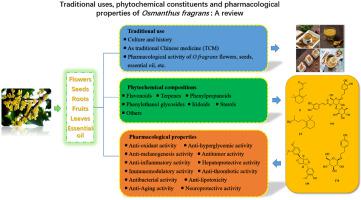Journal of Ethnopharmacology ( IF 4.8 ) Pub Date : 2022-04-09 , DOI: 10.1016/j.jep.2022.115273 Baojun Wang 1 , Fei Luan 1 , Yiwen Bao 1 , Xi Peng 1 , Zhili Rao 1 , Qiong Tang 1 , Nan Zeng 2

|
Ethnopharmacological relevance
Osmanthus fragrans Lour., is a medicinal plant distributed widely in some Asian countries including Japan and Korea and southwestern China. It has been used traditionally for the treatment of weakened vision, halitosis, panting, asthma, cough, toothache, stomachache, diarrhea, rheumatism, physique pain and hepatitis.
Aim of the review: Recent advances in traditional uses, botanical characteristics, distribution, taxonomy, phytochemical constituents, biological effects as well as the toxicities of O. fragrans are comprehensively presented and critically evaluated, and the underlying mechanism associated with the bioactivities of extracts, essential oil and components from this plant is also well summarized. In order to provide comprehensive scientific basis for the medical application and help interested researchers discover food and medicinal natural products from O. fragrans.
Materials and methods
All information was systematically gathered from globally accepted scientific databases by Internet databases, including Elsevier, ScienceDirect, PubMed, Web of Science, Wiley, Springer, SciFinder, ACS Publications, CNKI, WanFang, Google Scholar, Baidu Scholar, The Plant List Database, and other literature sources (Ph.D. and MSc dissertations). All published contributions on O. fragrans different languages were included and cited. The chemical structures of all isolated compounds were drawn by using ChemBioDraw Ultra 14.0 software.
Results
To date, more than 183 compounds were isolated and structurally identified from different plant parts of O. fragrans. Among them, ionone, ionol, flavonoids, polyphenols and iridoids, as the major bioactive substances, have been extensively studied and displayed the best bioactivity. Pharmacological studies demonstrated that O. fragrans and its active components had a wide range of biological activities, such as antioxidant, antitumor, anti-inflammatory, anti-hyperglycemic, anti-thrombotic, anti-melanogenesis, neuroprotective, and hepatoprotective activities, etc.
Conclusion
O. fragrans, as a food and medicinal resource, has a good health care function and important edible and medicinal value, and thus has good prospects for utilization. However, many studies on biological activities were mainly based on extracts and the bioactive ingredients of this plant, and the mechanism responsible for these extracts and ingredients have not been well identified and there is a gap in research regarding clinical effect and safety. Therefore, the detail in vitro and in vivo studies on the mechanisms of action of the pure bioactive compounds and more clinical studies are encouraged to be conducted to ensure safety and effectiveness of the plant for human use.































 京公网安备 11010802027423号
京公网安备 11010802027423号